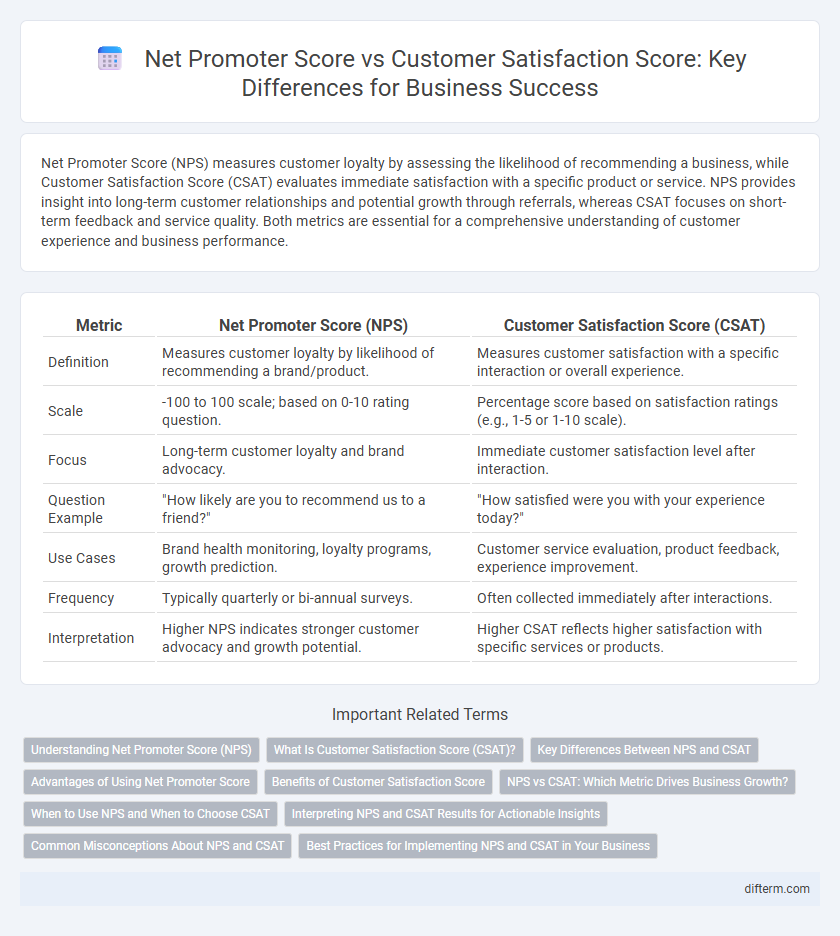Net Promoter Score (NPS) measures customer loyalty by assessing the likelihood of recommending a business, while Customer Satisfaction Score (CSAT) evaluates immediate satisfaction with a specific product or service. NPS provides insight into long-term customer relationships and potential growth through referrals, whereas CSAT focuses on short-term feedback and service quality. Both metrics are essential for a comprehensive understanding of customer experience and business performance.
Table of Comparison
| Metric | Net Promoter Score (NPS) | Customer Satisfaction Score (CSAT) |
|---|---|---|
| Definition | Measures customer loyalty by likelihood of recommending a brand/product. | Measures customer satisfaction with a specific interaction or overall experience. |
| Scale | -100 to 100 scale; based on 0-10 rating question. | Percentage score based on satisfaction ratings (e.g., 1-5 or 1-10 scale). |
| Focus | Long-term customer loyalty and brand advocacy. | Immediate customer satisfaction level after interaction. |
| Question Example | "How likely are you to recommend us to a friend?" | "How satisfied were you with your experience today?" |
| Use Cases | Brand health monitoring, loyalty programs, growth prediction. | Customer service evaluation, product feedback, experience improvement. |
| Frequency | Typically quarterly or bi-annual surveys. | Often collected immediately after interactions. |
| Interpretation | Higher NPS indicates stronger customer advocacy and growth potential. | Higher CSAT reflects higher satisfaction with specific services or products. |
Understanding Net Promoter Score (NPS)
Net Promoter Score (NPS) measures customer loyalty by asking how likely customers are to recommend a company's product or service on a scale of 0 to 10, categorizing respondents as promoters, passives, or detractors. Unlike Customer Satisfaction Score (CSAT), which gauges immediate satisfaction with a specific interaction, NPS focuses on long-term brand advocacy and growth potential. Companies leveraging NPS can identify promoters who drive referrals and detractors who signal risks to customer retention, making it a critical metric for strategic business decisions.
What Is Customer Satisfaction Score (CSAT)?
Customer Satisfaction Score (CSAT) measures the percentage of customers who express satisfaction with a company's products or services, typically gathered through direct feedback surveys. This metric is crucial for businesses to assess immediate customer experiences and improve service quality. Unlike Net Promoter Score (NPS), which gauges loyalty and likelihood to recommend, CSAT focuses specifically on short-term satisfaction levels following a specific interaction.
Key Differences Between NPS and CSAT
Net Promoter Score (NPS) measures customer loyalty by asking how likely customers are to recommend a brand, while Customer Satisfaction Score (CSAT) assesses immediate satisfaction with a specific product or service. NPS provides a long-term indicator of brand growth potential through promoter and detractor segmentation, whereas CSAT offers granular insights into customer experiences at distinct touchpoints. Businesses use NPS to gauge overall brand advocacy and CSAT to identify areas for operational improvement.
Advantages of Using Net Promoter Score
Net Promoter Score (NPS) provides a clear, actionable metric by categorizing customers into promoters, passives, and detractors, enabling businesses to prioritize efforts that drive growth. Its simplicity and industry-wide adoption facilitate benchmark comparisons across competitors, enhancing strategic decision-making. NPS directly correlates with customer loyalty and revenue, making it a powerful tool for predicting future business performance.
Benefits of Customer Satisfaction Score
Customer Satisfaction Score (CSAT) provides direct insights into specific customer experiences, enabling businesses to identify precise areas for improvement and enhance product or service quality. High CSAT scores correlate with increased customer loyalty, repeat purchases, and positive word-of-mouth, driving revenue growth. Unlike Net Promoter Score, CSAT offers immediate, actionable feedback that supports agile decision-making and targeted customer experience strategies.
NPS vs CSAT: Which Metric Drives Business Growth?
Net Promoter Score (NPS) gauges customer loyalty by measuring the likelihood of recommending a brand, making it a strong predictor of long-term business growth. Customer Satisfaction Score (CSAT) focuses on immediate satisfaction with a product or service, reflecting short-term customer experience. Studies show that while CSAT provides valuable feedback for operational improvements, NPS more directly correlates with increased revenue and customer retention, driving sustainable growth.
When to Use NPS and When to Choose CSAT
Net Promoter Score (NPS) is ideal for measuring long-term customer loyalty and predicting business growth by identifying promoters and detractors. Customer Satisfaction Score (CSAT) provides immediate feedback on specific interactions or transactions, making it useful for assessing short-term satisfaction and service quality. Choose NPS for strategic insights on overall brand perception and CSAT for tactical improvements in customer experience.
Interpreting NPS and CSAT Results for Actionable Insights
Interpreting Net Promoter Score (NPS) and Customer Satisfaction Score (CSAT) involves analyzing feedback to identify customer loyalty trends and immediate satisfaction levels. NPS provides insights into long-term customer advocacy by categorizing promoters, passives, and detractors, while CSAT measures direct response to specific interactions or products. Combining NPS and CSAT results enables businesses to prioritize improvements, optimize customer experience, and drive strategic growth through targeted actions.
Common Misconceptions About NPS and CSAT
Net Promoter Score (NPS) and Customer Satisfaction Score (CSAT) are often confused as interchangeable metrics, but NPS measures customer loyalty and likelihood to recommend, while CSAT gauges immediate satisfaction with a specific interaction. A common misconception is that a high CSAT guarantees customer loyalty, yet NPS provides deeper insights into long-term customer relationships and advocacy. Businesses relying solely on CSAT may overlook critical growth opportunities that NPS can reveal through its focus on promoters and detractors.
Best Practices for Implementing NPS and CSAT in Your Business
Implementing Net Promoter Score (NPS) and Customer Satisfaction Score (CSAT) effectively involves strategically timing surveys to capture authentic customer feedback during key interaction points. Leveraging data analytics to segment customers based on NPS and CSAT insights allows businesses to tailor improvements and personalize engagement efforts. Integrating NPS and CSAT metrics into overall performance dashboards ensures continuous monitoring and drives proactive customer-centric strategies that enhance loyalty and business growth.
net promoter score vs customer satisfaction score Infographic

 difterm.com
difterm.com